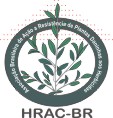DETERMINATION OF RESIDUAL EFFECT OF INDAZIFLAM AND AMICARBAZONE IN TWO SOILS THROUGH BIOASSAY
Resumo
The herbicides indaziflam and amicarbazone effectively control weeds, as they persist for long extensions in the soil. The objective of this work was to evaluate the residual effect of indaziflam and amicarbazone in contrasting textures. Two experiments were conducted, one experiment for each herbicide using a the randomized block design, with four replications, in a 2x6+1 factorial scheme, that is, two types of soils, six application times (0, 20, 40, 60, 80 and 100 days after application - DAA) and a control. Used as doses of 100 and 1.400 g ha-1, for indaziflam and amicarbazone, respectively. At each evaluation period, the cucumber (Cucumis sativus L.) was sown and the visual intoxication of the species was measured at 21 days after sowing. At 0, 20 and 40 DAA of amicarbazone, phytointoxication was 100% for both soils. It was observed at 100 DAA, ditostically reducing phytointoxication, close to 0%, in sandy soil (DT50 @ 56 days) and 30% in clayey soil (DT50 @ 59 days). Indaziflam provided 100% phytointoxication at all times. It was concluded that the indaziflam had greater residual activity than amicarbazone, regardless of the soil. Already, for the amicarbazone, the effect was higher on the clay texture.
Palavras-chave
Texto completo:
PDFDOI: https://doi.org/10.7824/rbh.v18i3.617
Apontamentos
- Não há apontamentos.
ISSN (IMPRESSO de 2000 a 2005) 1517-9443
Complexo Empresarial Oscar Fuganti
Rua Santa Catarina, 50 - 13º andar - sala 1302
Londrina - Paraná
CEP: 86010-470
Email: contato@rbherbicidas.com.br
TEL: (43) 3344-3364
Segunda à Sexta — 12:00 às 18:0











